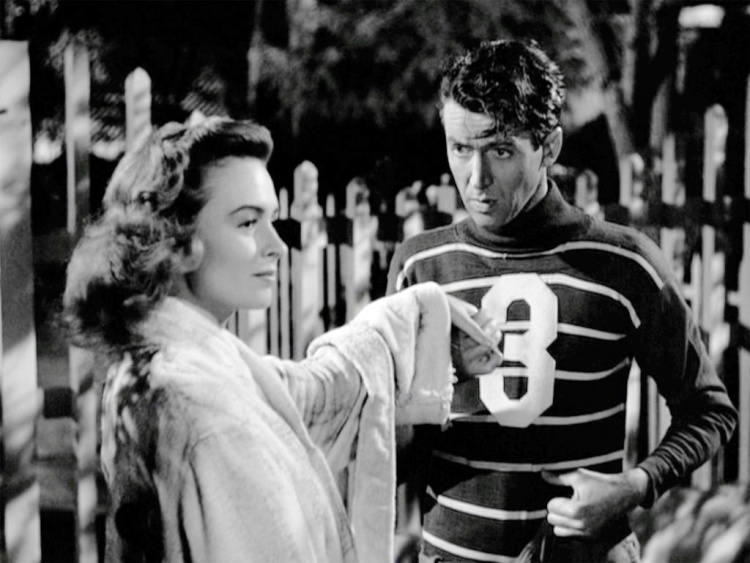It's a Wonderful Life (1946) is one of my favorite movies. It has everything anyone could want to see in a film. There's drama, romance, action, twists, and even a villain. I was lucky that I was able to meet and interview Karolyn Grimes who played Zuzu Bailey early on in my blogging journey which you can read about HERE.
This movie means so much to me. George Bailey's story is an important reminder that life is challenging but valuable. If you love It's a Wonderful Life (1946) as much as I do, you may enjoy these bits of trivia about the film. What are some of your favorite classic holiday movies?
"It's a Wonderful Life" represented the first and last time Capra produced, financed, directed and co-wrote a film.
Director Frank Capra often said that this was his favorite of all his films.
When the rights were still held at RKO, Cary Grant was slated to play the lead role of George Bailey made iconic by Jimmy Stewart.
The film, although now considered a classic, was such a financial disappointment that it busted Capra's production company, Liberty Films.
The set for Bedford Falls was constructed in two months and was one of the longest sets that had ever been made for an American movie. It covered four acres of RKO's Encino Ranch. It included 75 stores and buildings, a main street, a factory district and a large residential and slum area. Main Street was 300 yards long--three whole city blocks.
According to Matzen, "It's a Wonderful Life" was Jimmy Stewart's first picture after 20 months on the front lines of WWII. He reportedly suffered post-traumatic stress disorder while filming.
The film takes place from 1919 to December 24, 1945.
James Stewart was nervous about the phone kiss scene because it was his first onscreen kiss since his return to Hollywood after the war. Under director Frank Capra's watchful eye, Stewart filmed the scene in only one unrehearsed take, and it worked so well that part of the embrace was cut because it was too passionate to pass the censors.
A photograph of James Stewart at the age of six months, donated by his parents, was included in the Bailey home set.
Robert J. Anderson, who played young George Bailey, said Mr. Gower actor H.B. Warner really was drunk in the scene in which he slaps George. The real slaps caused real blood to ooze out of Anderson's ear. After the cameras stopped rolling, he comforted Anderson.
George hopes to go to college to "learn how to build things." In real life, James Stewart majored in architecture at Princeton University.
For the scene that required Donna Reed to throw a rock through the window of the Granville house, director Frank Capra hired a marksman to shoot it out on cue. To everyone's amazement, Reed broke the window by herself. She had played baseball in high school and had a strong throwing arm.
As Uncle Billy drunkenly leaves the Bailey home, it sounds as if he stumbles into some trash cans on the sidewalk. In fact, a crew member dropped a large tray of props right after Thomas Mitchell went off-screen. James Stewart began laughing, and Mitchell quickly improvised, "I'm alright, I'm okay!" Director Frank Capra decided to use this take in the final cut and gave the stagehand a $10 bonus for "improving the sound."
The gym floor that opens in the middle to reveal the swimming pool underneath was filmed at Beverly Hills High School In Beverly Hills, California, USA was real and is still in regular use.
The disgruntled prankster who opens the gymnasium floor, revealing the pool during the school dance, is none other than Carl Switzer, who played Alfalfa in the Little Rascals shorts.
Sam Wainwright's catchphrase "hee-haw" is said 13 times throughout the movie, and not always by him.
While filming the scene in which George prays in the bar, James Stewart was so overcome that he began to sob. Frank Capra later re-framed and blew up the shot because he wanted to catch that expression on Stewart's face. This is why the shot looks so grainy compared with the rest of the film.
Actor and producer Sheldon Leonard said that he only agreed to play Nick the bartender so he could buy baseball tickets with his paycheck.
During the bank run scene, director Frank Capra rehearsed the scene between James Stewart and Ellen Corby several times. When Corby's character was asked how much money she needed, she replied $17, which was in the script. Just prior to the first actual take, Capra took Corby aside and told her to give Stewart an odd number, thinking it would be funnier. When she said "17.50" to Stewart, he was taken off-guard and impulsively kissed her, which was not in the script. Stewart's spontaneous reply was so genuine that Capra left the scene in the final film.























Post a Comment